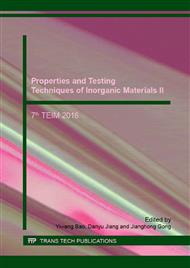p.308
p.316
p.323
p.328
p.333
p.338
p.345
p.350
p.355
Heterojunction Structure ZnO/TiO2 Nanorods with Enhanced Photoelectrochemical Properties
Abstract:
This paper describes a simple two-step hydrothermal method for the design of heterojunction structure combined with TiO2 nanorods coated with ZnO nanoparticles. TiO2 nanorods on F-doped tin oxide (FTO) conducting glass are synthesized by hydrothermal method and ZnO coating is prepared through a two-step procedure. The XRD patterns confirm that the nanostructure consists of rutile TiO2 and wurtzite ZnO without any other impure phase. The FE-SEM results show that ZnO is uniformly distributing on the surface of TiO2 nanorods, forming a well-connecting heterojunction. PL studies and UV-vis absorption spectra present the enhanced optical performance of ZnO/TiO2 heterojunction. The heterojunction structure ZnO/TiO2 nanorods show excellent photoelectrochemical performance. The performance and the preparation parameters are also optimized accordingly.
Info:
Periodical:
Pages:
333-337
Citation:
Online since:
January 2017
Authors:
Price:
Сopyright:
© 2017 Trans Tech Publications Ltd. All Rights Reserved
Share:
Citation:


